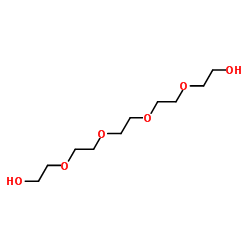4792-15-8
| Name | Pentaethylene glycol |
|---|---|
| Synonyms |
Pentaethylene Glycol
3,6,9,12-Tetraoxatetradecane-1,14-diol,Pentaglycol MFCD00002878 EINECS 225-341-4 pentaethyleneglycol 2-[2-[2-[2-(2-hydroxyethoxy)ethoxy]ethoxy]ethoxy]ethanol 3,6,9,12-Tetraoxatetradecane-1,14-diol |
| Description | Pentaethylene glycol is a PEG-based PROTAC linker that can be used in the synthesis of PROTACs[1]. |
|---|---|
| Related Catalog | |
| Target |
PEGs |
| In Vitro | PROTACs contain two different ligands connected by a linker; one is a ligand for an E3 ubiquitin ligase and the other is for the target protein. PROTACs exploit the intracellular ubiquitin-proteasome system to selectively degrade target proteins[1]. |
| References |
| Density | 1.1±0.1 g/cm3 |
|---|---|
| Boiling Point | 356.1±32.0 °C at 760 mmHg |
| Molecular Formula | C10H22O6 |
| Molecular Weight | 238.278 |
| Flash Point | 169.2±25.1 °C |
| Exact Mass | 238.141632 |
| PSA | 77.38000 |
| LogP | -2.59 |
| Vapour Pressure | 0.0±1.8 mmHg at 25°C |
| Index of Refraction | 1.458 |
| Stability | Stable. Combustible. Incompatible with strong oxidizing agents, acid chlorides, acid anhydrides. |
CHEMICAL IDENTIFICATION
HEALTH HAZARD DATAACUTE TOXICITY DATA
|
| Symbol |

GHS07 |
|---|---|
| Signal Word | Warning |
| Hazard Statements | H315-H319-H335 |
| Precautionary Statements | P261-P305 + P351 + P338 |
| Personal Protective Equipment | Eyeshields;full-face respirator (US);Gloves;multi-purpose combination respirator cartridge (US);type ABEK (EN14387) respirator filter |
| Hazard Codes | Xi:Irritant; |
| Risk Phrases | R36/37/38 |
| Safety Phrases | S26-S36 |
| RIDADR | NONH for all modes of transport |
| WGK Germany | 3 |
| RTECS | RZ2670000 |
| HS Code | 2909499000 |
| HS Code | 2909499000 |
|---|---|
| Summary | 2909499000. ether-alcohols and their halogenated, sulphonated, nitrated or nitrosated derivatives. VAT:17.0%. Tax rebate rate:9.0%. . MFN tariff:5.5%. General tariff:30.0% |

